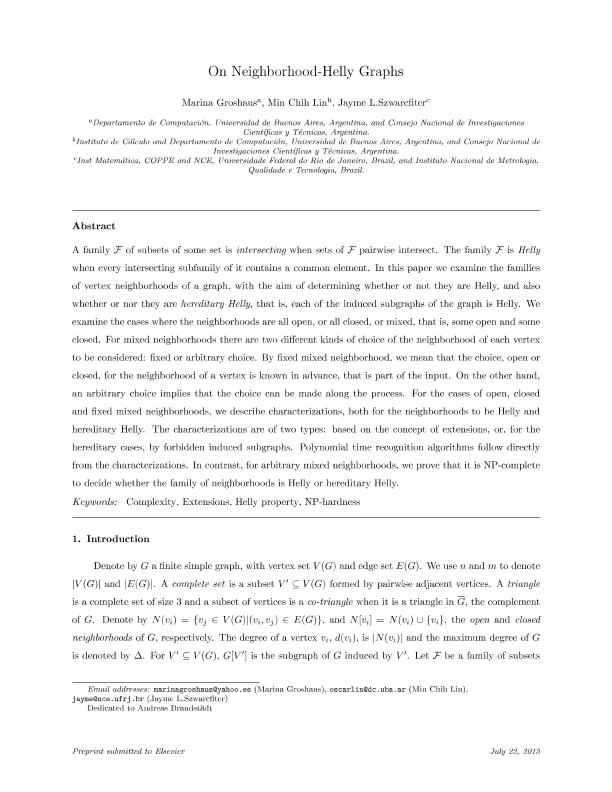Mostrar el registro sencillo del ítem
dc.contributor.author
Groshaus, Marina Esther

dc.contributor.author
Lin, Min Chih

dc.contributor.author
Szwarcfiter, Jayme L.

dc.date.available
2018-09-17T16:53:22Z
dc.date.issued
2017-01
dc.identifier.citation
Groshaus, Marina Esther; Lin, Min Chih; Szwarcfiter, Jayme L.; On neighborhood-Helly graphs; Elsevier Science; Discrete Applied Mathematics; 216; 1-2017; 191-202
dc.identifier.issn
0166-218X
dc.identifier.uri
http://hdl.handle.net/11336/59879
dc.description.abstract
A family F of subsets of some set is intersecting when sets of F pairwise intersect. The family F is Helly when every intersecting subfamily of it contains a common element. In this paper we examine the families of vertex neighborhoods of a graph, with the aim of determining whether or not they are Helly, and also whether or nor they are hereditary Helly, that is, each of the induced subgraphs of the graph is Helly. We examine the cases where the neighborhoods are all open, or all closed, or mixed, that is, some open and some closed. For mixed neighborhoods there are two different kinds of choice of the neighborhood of each vertex to be considered: fixed or arbitrary choice. By fixed mixed neighborhood, we mean that the choice, open or closed, for the neighborhood of a vertex is known in advance, that is part of the input. On the other hand, an arbitrary choice implies that the choice can be made along the process. For the cases of open, closed and fixed mixed neighborhoods, we describe characterizations, both for the neighborhoods to be Helly and hereditary Helly. The characterizations are of two types: based on the concept of extensions, or, for the hereditary cases, by forbidden induced subgraphs. Polynomial time recognition algorithms follow directly from the characterizations. In contrast, for arbitrary mixed neighborhoods, we prove that it is NP-complete to decide whether the family of neighborhoods is Helly or hereditary Helly.
dc.format
application/pdf
dc.language.iso
eng
dc.publisher
Elsevier Science

dc.rights
info:eu-repo/semantics/openAccess
dc.rights.uri
https://creativecommons.org/licenses/by-nc-nd/2.5/ar/
dc.subject
Complexity
dc.subject
Extensions
dc.subject
Helly Property
dc.subject
Np-Hardness
dc.subject.classification
Ciencias de la Computación

dc.subject.classification
Ciencias de la Computación e Información

dc.subject.classification
CIENCIAS NATURALES Y EXACTAS

dc.title
On neighborhood-Helly graphs
dc.type
info:eu-repo/semantics/article
dc.type
info:ar-repo/semantics/artículo
dc.type
info:eu-repo/semantics/publishedVersion
dc.date.updated
2018-09-14T14:26:56Z
dc.journal.volume
216
dc.journal.pagination
191-202
dc.journal.pais
Países Bajos

dc.journal.ciudad
Amsterdam
dc.description.fil
Fil: Groshaus, Marina Esther. Universidad de Buenos Aires. Facultad de Ciencias Exactas y Naturales. Departamento de Computación; Argentina. Consejo Nacional de Investigaciones Científicas y Técnicas; Argentina
dc.description.fil
Fil: Lin, Min Chih. Universidad de Buenos Aires. Facultad de Ciencias Exactas y Naturales. Instituto de Cálculo; Argentina. Universidad de Buenos Aires. Facultad de Ciencias Exactas y Naturales. Departamento de Computación; Argentina. Consejo Nacional de Investigaciones Científicas y Técnicas; Argentina
dc.description.fil
Fil: Szwarcfiter, Jayme L.. Universidade Federal do Rio de Janeiro; Brasil. Instituto Nacional de Metrologia, Qualidade e Tecnologia; Brasil
dc.journal.title
Discrete Applied Mathematics

dc.relation.alternativeid
info:eu-repo/semantics/altIdentifier/doi/http://dx.doi.org/10.1016/j.dam.2016.04.029
dc.relation.alternativeid
info:eu-repo/semantics/altIdentifier/url/https://www.sciencedirect.com/science/article/pii/S0166218X16302013
Archivos asociados
